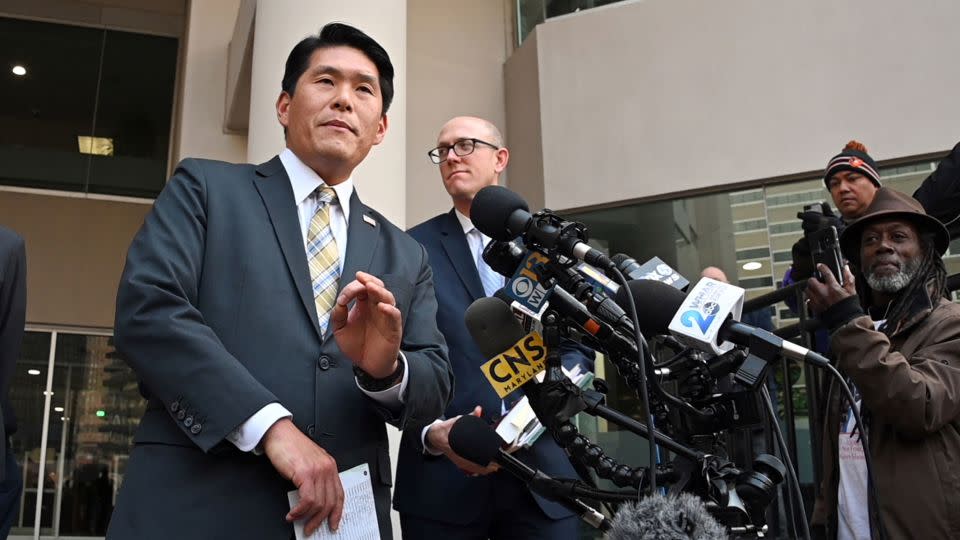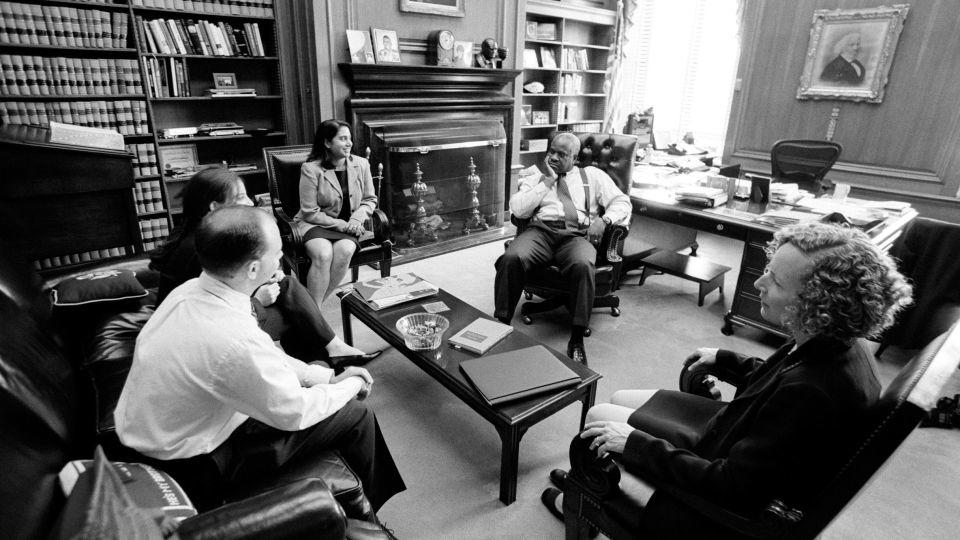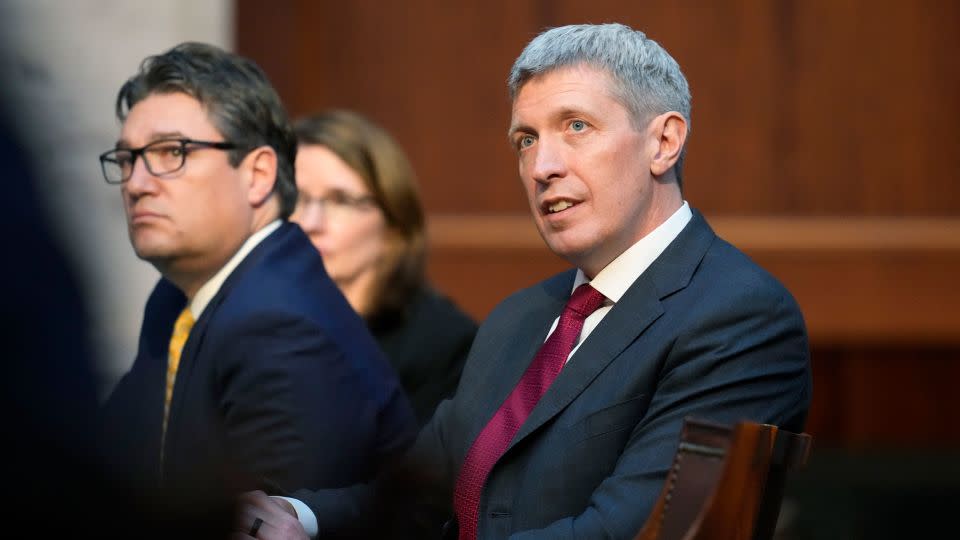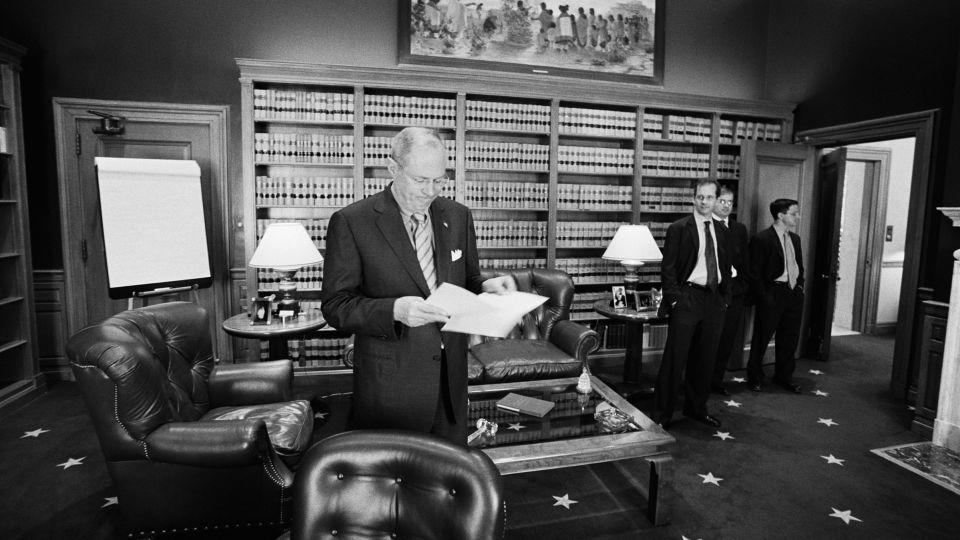Inside the exclusive world of Supreme Court clerks driving America’s legal controversies
- Oops!Something went wrong.Please try again later.
- Oops!Something went wrong.Please try again later.
- Oops!Something went wrong.Please try again later.
- Oops!Something went wrong.Please try again later.
- Oops!Something went wrong.Please try again later.
Twenty years ago, as Supreme Court justices were deciding cases that tested college affirmative action, a ban on same-sex relations and a “three-strikes” law that put convicts in prison for life, their elite young law clerks were growing agitated and divided.
Some conservative clerks stopped eating lunch with their liberal counterparts and abandoned weekly “happy hours.” Even a benefit Jell-O-eating contest (no hands) generated ideological discord over the charity groups selected for the money raised.
Today, many of the 35 clerks from that contentious session, two decades into their own careers, are at the center of America’s most incendiary legal battles. The ideological fault lines from their time at the court are today shaping constitutional law and US politics.
A one-year post as a Supreme Court clerk has long been a ticket to power, influence and wealth. Law firms offer signing bonuses of $450,000 to former clerks, most of whom come from Ivy League and other top-tier law schools.
It may be money well spent. Former Supreme Court clerks fill the highest echelons of the judiciary. Studies have shown that the justices are more likely to take an appeal if filed by a former clerk than by someone who never worked for a justice.
Former President Donald Trump chose former Supreme Court clerks for all three of his appointments to the high court. And of his total 54 US appellate appointments, 21 nominees were Supreme Court clerks, which is a modern record of nearly 40%.
Of the many players who variously inhabit the court’s ecosystem – top lawyers, esteemed professors and prominent commentators – former clerks play an enormous role. Their time at the court was formative, not just for the connections they made, but as it informed their future cases and roles in America’s culture clashes.
For the class of 2002-2003, many then-clerks are fighting the same battles, only now at higher levels of the profession.
“There was deep and obvious contempt for the progressive left,” recalled liberal Gil Seinfeld, now a University of Michigan law professor, of right-wing clerks. “So far as I could tell, it was not contempt for the people on the left, but for their approach toward thinking about the law. They saw that approach as completely unrestrained and calculated to allow left-leaning judges to do more or less whatever they wanted in the cases that mattered most.”
Seinfeld added: “At the same time, liberal clerks were hardly enthusiastic about conservative interpretive methods, and many of us viewed those methods as thinly veiled techniques for advancing a conservative political agenda.”
Adam Mortara, who served Justice Clarence Thomas 20 years ago and is now a leading right-wing litigator, reinforced that perceived dichotomy.

“Winning arguments during that era of the court was much more like, ‘Tell me about the vibe. How are you going to feel about this? What are the policy consequences?’” Mortara told CNN.
“I found the experience dispiriting, unlike anything that I had been expecting and wanted out of the law. I ended up loathing a very small group of law clerks and it became impossible for me to socialize with them,” he added.
Today’s more entrenched clerkship-to-judgeship path perpetuates the impact of certain justices on the law, through their acolytes.
“Probably more important than their influence during the one year as a clerk at the court,” said Harvard law professor and former dean Martha Minow, “a former clerk has access to knowledge, mores, strategies and ambition that can lead to outsized influence as their careers develop.”
Mortara this year essentially counteracted an experience from 20 years ago. He was a trial lawyer in the challenge to Harvard’s affirmative action practices brought by Students for Fair Admissions, the case that led to the Supreme Court’s milestone ruling against race-based admissions policies nationwide that reversed a ruling from 2003 when Mortara was a law clerk to Thomas, then in the minority.
Mortara is currently on contract with the state of Tennessee to defend its ban on gender-affirming drugs and surgery for transgender minors and he has been enlisted by Wisconsin Republican officials in their ongoing redistricting litigation battle with Democrats.
Jonathan Mitchell, a fellow conservative from the 2002-2003 term, is even more prominent across America’s most divisive social policy issues. The former clerk to Justice Antonin Scalia engineered the Texas abortion ban known as SB 8, which prohibited the procedure at roughly six-weeks of pregnancy with few exceptions. The Supreme Court’s consideration of that law laid the groundwork for the justices’ ultimate decision reversing Roe v. Wade last year.
Among Mitchell’s current litigation in lower courts are two religion-based claims to LGBTQ-related coverage in the Affordable Care Act’s preventative services mandate and in Title VII of the Civil Rights Act, which applies to workplace practices. At the Supreme Court, Mitchell is the lead lawyer for a challenge to be heard in the spring to the federal government’s ban on rapid-fire “bump stock” firearms.
Another conservative clerk from the class 20 years ago, David Stras, was one of Trump’s first appellate court appointees, to the St. Louis-based 8th US Circuit Court of Appeals.
Stras in November authored a groundbreaking opinion that would eliminate remedies for discrimination under the 1965 Voting Rights Act. His stance – that only the US Department of Justice, not private parties, can sue for voter discrimination – went further than any Supreme Court decision on the subject. His position, if affirmed by the high court, could dramatically diminish the ability of Black and Hispanic voters to vindicate their rights.
Emin Toro, who worked with Stras in Thomas’ chambers, became another Trump appointee, yet to a less ideological and less tenured post: the US Tax Court in 2019. Tax Court judges serve for 15 years, rather than for life.
Another former clerk from that session, Robert Hur, who worked for then-Chief Justice William Rehnquist, is operating in a highly visible political sphere as the special counsel investigating Joe Biden’s possible mishandling of classified documents. The investigation could have implications for the president’s reelection bid and could separately reverberate in the Florida classified-documents case involving Trump, Biden’s leading GOP opponent.
Among the law clerks on the left during the 2002-2003 term was Eric Olson, a former Colorado state solicitor general who worked for Justice John Paul Stevens and is now bringing litigation in Colorado to keep Trump off the 2024 presidential ballot because of his role in the January 6, 2021, insurrection.
The voters challenging Trump contend that a provision of the Fourteenth Amendment forbidding certain officials who have “engaged in insurrection” from holding office should block the former president. Two of Olson’s partners on the case, Sean Grimsley and Jason Murray, were clerks after Olson.
Two other liberals from the 2002-2003 term are now federal judges: Toby Heytens, one of Biden’s first US appellate court appointees, was in the majority of an important 4th US Circuit Court of Appeals opinion in a high school admissions dispute pending at the high court, and Jesse Furman, an Obama administration district court appointee whose ruling led to a Supreme Court showdown over Trump’s plan to add a citizenship question to the US Census.

Cristina Rodriguez, also on the left that term and now a Yale law professor, was appointed by Biden to co-chair his Presidential Commission on the Supreme Court.
Unlike Trump in his judicial selection, Biden has put a priority on diversity of background and legal experience. Yet his one choice for a Supreme Court vacancy, Ketanji Brown Jackson, the first Black woman justice, was also a Supreme Court clerk, to Justice Stephen Breyer (who himself was a law clerk to Justice Arthur Goldberg in the mid-1960s).
Today, a record six of the nine justices were once Supreme Court clerks: Chief Justice John Roberts (1980-81) and Associate Justices Elena Kagan (1988-89); Neil Gorsuch and Brett Kavanaugh (both in the 1993-94 term); Amy Coney Barrett (1998-99) and Jackson (1999-2000).
How to get on the fast track
Large law firms vie for the inside perspective and today are willing to provide signing bonuses of $450,000, which, for comparison, easily exceed the justices’ annual pay. (The eight associate justices make $285,400 a year, the chief justice $298,500.)
Each of the nine justices typically hires four law clerks to help review petitions from people who have lost cases in lower courts. The clerks assist with research and the writing of opinions.
Clerks are selected for the most part from the Ivy League and top schools such as the University of Chicago and Stanford, and they usually first hold a one-year clerkship with a US appellate judge.
Twenty years ago, Rehnquist and Stevens, both Midwesterners, were receptive to candidates with a state-university background. In the 2002-2003 term, each hired graduates from the University of Illinois law school.
Thomas, the only remaining justice from 20 years ago, was also open then (and now) to top students from a range of schools, even as he has strictly favored conservatives. Stras graduated from the University of Kansas law school, and Toro from the University of North Carolina law school.
Now-retired justices Breyer and David Souter, on the other hand, hired only Harvard and Yale law graduates for their total eight combined clerks for the 2002-2003 term.
As much as a clerkship rewards high-achieving students and brings future success, many lawyers widely regarded as brilliant chose never to apply or fail to make the cut. Conversely, there have been former clerks whose colleagues describe them as middling. And irrespective of talent, no clerks exceed the importance of the life-tenured justices they serve.
There already was a well-worn path for former clerks to corporate law offices, university professorships and top government jobs. Harvard’s Minow, a former law clerk herself to Justice Thurgood Marshall in the 1980-1981 session, said one of most significant developments in the trajectories of former clerks has been their presence on the federal bench.

She also pointed to the clerk pipeline cultivated by the Federalist Society, the conservative group that has recommended judicial candidates for Republican presidents since the 1980s and became an especially powerful partner to the Trump White House.
“The same way that leaders of the Federalist Society have groomed the short list for judicial appointments, the Federalist Society has increasingly focused on grooming clerks who will support the judges whom the Federalist Society has helped to place on the bench,” Minow said.
Asked about the Federalist Society’s pipeline, Leonard Leo, a longtime leader of the organization, responded in an email, “It isn’t too surprising that Federalist students get High Court clerkships – they tend to be intellectually engaged and rigorous, which is key to judges seeking clerks.”
2003 flashpoints
CNN spoke with more than a dozen clerks from the term and reviewed newly available papers of the late Justice Stevens at the Library of Congress for a window into deliberations and the atmosphere that year.
Many clerks recall constructive conversations and say they forged enduring friendships. Among the lighter moments were performances by Mitchell on piano and fellow clerk Allyson Newton Ho on the harp.
Then a clerk to Sandra Day O’Connor, Ho now is a leading appellate lawyer at a large firm and, in her pro bono practice, has focused on conservative religious liberty causes. She is married to another former clerk, James Ho (Thomas, 2005-2006), whom Trump appointed to the 5th US Circuit Court of Appeals.
Mixed with the warm memories of new relationships, a series of flashpoint cases remain foremost in many minds.
Two of those controversies generated alienation and disillusionment among some conservatives.
The cases arose from constitutional challenges to a Texas ban on intimate relations between same-sex couples and college affirmative action at the University of Michigan. O’Connor and Kennedy, centrist conservative justices, controlled the outcome of those cases.
Both decisions were bitterly fought and went down to the final days of the session.
“By the time you get to the end of a Supreme Court term,” said former Stevens clerk Amy Wildermuth, “everybody has been working around the clock, with high stakes cases. And, frankly, we were all so young. As I look back, I can see how it’s sort of a boiling pot.”
Wildermuth, who now teaches law at Ohio State, accentuated the positive side of her experience even as she was aware of angst in other chambers.
The expectations going into the term likely affected how some clerks felt at the end. Two years earlier, the court had decided the 2000 presidential election for Republican George W. Bush and it had been delivering a string of other conservative victories. While the right-wing likely anticipated more, clerks working for liberal Stevens, as Wildermuth and Olson were, or Justices Souter and Ruth Bader Ginsburg (as Furman and Heytens, respectively, were) could have believed they would be relegated to drafting dissenting opinions.
But that’s not what happened, and further driving a wedge between camps of clerks was that conservative justices at the center of the court cast crucial votes for liberal outcomes. Kennedy wrote the court’s opinion favoring gay rights in the case of Lawrence v. Texas, and O’Connor wrote the decision upholding University of Michigan affirmative action in Grutter v. Bollinger.
“I do think that relationships in the building became generally more strained as the term wore on,” said Seinfeld, working for Scalia, who often hired one “counter-clerk” among the four. “As a liberal clerk in a conservative chambers, that was certainly true for me. As we got toward May and June, I spent less and less time in my own office and more time with friends in the Souter and Breyer chambers.”
Conservatives such as Mortara and Mitchell banded together in distress.
“What was a dispiriting about the experience, for formalists like Jonathan and me, was the jurisprudential approach of the center of the court,” Mortara said.
How decisions developed and the center held
Stevens’ papers reveal how Kennedy went through multiple drafts to ground protection for gay sexual activity in the liberty guarantee of the Constitution’s due process clause.
Wildermuth, the papers show, assisted O’Connor with a concurring opinion that joined Kennedy’s judgment striking down anti-sodomy bans. Some 17 years earlier, O’Connor had voted to uphold such bans. She was ready to turn away from that precedent in Bowers v. Hardwick, on alternate constitutional grounds from Kennedy. Through her clerks, O’Connor sought advice on some wording from Wildermuth, the only openly gay clerk at the time.
Tensions over the gay rights case ran high for two Scalia clerks – for decidedly different reasons. Scalia vehemently disagreed with the majority view of a private right for same-sex relations.
Seinfeld said he knew even before he read what Scalia was writing in dissent that he wanted no part of it.
“Today’s opinion is the product of a Court,” Scalia said in his dissent, “which is the product of a law-profession culture, that has largely signed on to the so-called homosexual agenda, by which I mean the agenda promoted by some homosexual activists directed at eliminating the moral opprobrium that has traditionally attached to homosexual conduct.”

Seinfeld said Scalia allowed him to escape any research or editing related to that dissenting opinion, and Seinfeld told CNN Scalia never seemed to hold Seinfeld’s choice against him.
Co-clerk Mitchell, on the other hand, defended Scalia’s dissenting position. In an essay after Scalia died, Mitchell said he believed that the 1986 case of Bowers v. Hardwick, “clearly and unambiguously” resolved the issue.
Mitchell has recently been involved in litigation to win a religious exemption from LGBTQ claims of discrimination under Title VII for private businesses. In his separate case against an Affordable Care Act preventative services requirement, he has argued that requiring medications to protect against HIV violate a federal religious-liberty statute. He is also representing a Texas justice of the peace who refuses to officiate same-sex marriage ceremonies.
Mitchell has backed Mortara as he defends Tennessee’s ban on sex-transition healthcare for adolescents experiencing gender dysphoria. Three transgender youths and their families are suing the state to try to block the law; their appeal is pending at the Supreme Court.
Affirmative action then and now
The 2003 affirmative action case from the University of Michigan took on greater salience this year as the Supreme Court reconsidered the ruling and ultimately reversed it.
Twenty years ago, the court endorsed race-based admissions practices for student-body diversity, affirming the 1978 landmark Regents of the University of California v. Bakke. As part of her majority decision, O’Connor created a 25-year endpoint.
Multiple former clerks from that term who spoke with CNN on the condition their names not be used described rancor over O’Connor’s 25-year reference. The justices had disagreed over how strongly that time limit should be taken.
“We expect that 25 years from now, the use of racial preferences will no longer be necessary to further the interest approved today,” she had written, a statement that seemed more aspirational than foundational.
Clerks said conservatives worked hard to cement that into a formal principle, or “holding” of the case, and liberals, conversely, wanted to minimize its force.
Thomas, who opposed the decision endorsing affirmative action, wrote, “I agree with the Court’s holding that racial discrimination in higher education admissions will be illegal in 25 years.”
Meanwhile, Ginsburg, joined by Breyer, tried to cast that “25 years” as an objective, rather than command. “From today’s vantage point, one may hope, but not firmly forecast, that over the next generation’s span, progress toward nondiscrimination and genuinely equal opportunity will make it safe to sunset affirmative action.”

Mortara, Thomas’ clerk, and other lawyers representing Students for Fair Admissions, revived Thomas’ view in their case against Harvard. They wrote in a brief, “Grutter concludes with a warning that the Court expects ‘racial preferences will no longer be necessary’ in ‘25 years.’ This statement was not wishful thinking, but rather stemmed from a legal principle.”
The court majority that struck down affirmative action agreed with that assessment.
Asked by CNN whether he thought, back in 2003, that he would be in a position to someday take advantage of Thomas’ take on the 25-years, Mortara said, “Certainly not. Certainly not.”
Andrew DeVooght, a clerk for then-Chief Justice Rehnquist 20 years ago and now working for a large firm in Chicago, witnessed first-hand the disappointment of further-right clerks as decisions were in the final stages.
“There was a group on the conservative side that felt like they got their clocks cleaned our year,” he said.
But today’s court, with its conservative supermajority and no centrist successor to O’Connor or Kennedy, is markedly different. And the clerks who 20 years ago walked away upset and disillusioned now hold the ideological advantage.
For more CNN news and newsletters create an account at CNN.com

